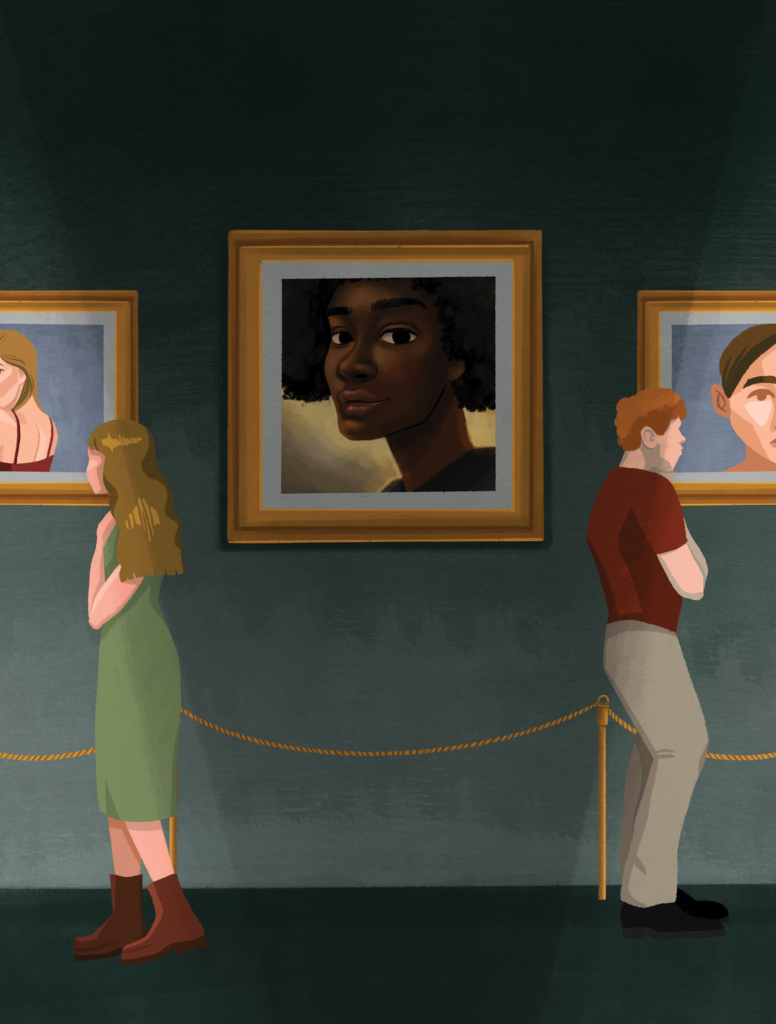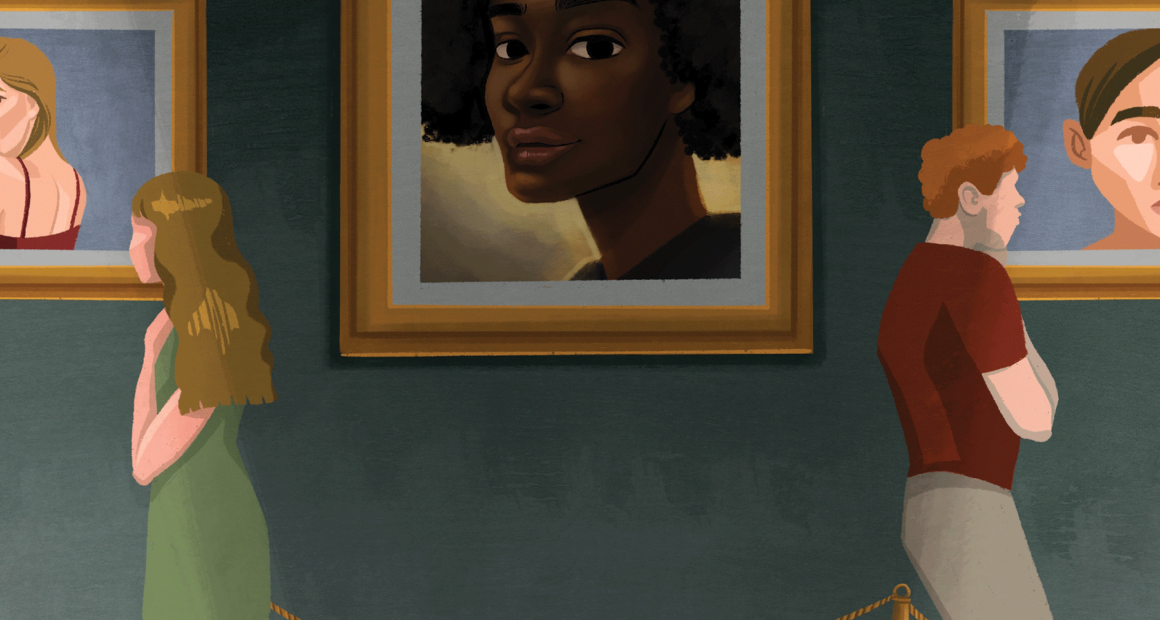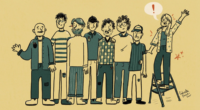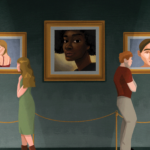Black artists are at the forefront of Canada’s creative scene. Why aren’t journalists telling their stories?

On a cold evening late last fall, the crisp air urges guests to pull their coats tighter. When guests step inside capsul Studio in Toronto’s Liberty Village neighbourhood, the space radiates coziness, not just from the heating but from the energy of attendees. Conversations mix with the soft hum of background music.
Everyone is lit up with smiles as they maneuver through the gallery, admiring each piece. Someone leans to sniff the knitted yellow, red, and blue tulips, part of the FEELS solo exhibition, and a friend stifles a laugh. Black and white photographs line three walls of the room. On the fourth wall, photos of yellow, red, and blue hang high with each image embodying emotions of joy, passion, and solitude, respectively. Multidisciplinary artist Percy Eriamiator uses these colours to emphasize the spectrum of feelings we embrace and abandon in personal and collective experiences. Viewers linger in front of a mirror piece Eriamiator created, Threads of Reflection, intended for people to see themselves in the work, to feel represented, even without their photos on display.
It’s what any artist would want on opening night, and it’s what Eriamiator has dreamed of. She moves through the crowd, greeting visitors with her warm smile revealing a blend of pride and nervousness. After months of preparation, FEELS, an interactive installation exploring the emotional spectrum, is here.
Eriamiator was born in Nigeria and moved to Canada as a teenager. Art has always been a central part of her life. From sharing outfit-of-the-day videos to designing custom knitwear, her work has often been notable. But the transition from Instagram posts to a solo exhibition marks a significant milestone. When the music stops, she sees the room filled with the spirit of community and support, and thanks everyone for coming. In this intimate environment, one absence stands out. Among the dozens who came to the launch, only one journalist is here—me.
As a journalism student with a passion for fashion, arts, and culture, I’ve become increasingly aware of how little attention stories like these receive in Canada’s legacy media. I’ve watched close friends and creatives get overlooked by journalists despite gaining significant traction on social media. I’ve noticed how often the work of Black artists is confined to niche spaces. This absence does a disservice to the richness of Black Canadian culture. “It’s disheartening to pour so much into our craft only to feel the media turning a blind eye,” says Eriamiator. “Our work deserves to be part of the bigger conversation.”
While the decline of arts journalism affects all independent creatives, the burden is disproportionately felt by Black artists. As news organizations scramble to allocate resources for arts coverage, the stories of Black artists such as Eriamiator, painter Neigh Ramirez, and photographer Simone Chnarakis are often pushed aside. According to a report by the Canada Council for the Arts, Black artists make up approximately 14 percent of the artist population in Toronto, Vancouver, and Calgary combined, yet their representation in media coverage is significantly lower. This gap is even more pronounced when considering the systemic challenges that Black creatives face, ranging from underrepresentation to the constant battle for recognition in predominantly white spaces.
The decline of arts and culture journalism in Canada has been driven by media consolidation, the rise of digital platforms, and economic changes within the industry. As large media corporations dominate, smaller publications suffer the consequences, with many being forced to close or reduce coverage. Digital platforms, while offering broader access, often lack the resources for in-depth reporting. This shift has marginalized arts journalism, leaving fewer voices to cover local and niche cultural topics. Arts and culture journalism has become so devalued in Canada that stories like Eriamiator’s no longer seem to matter. But if journalism is supposed to reflect the diversity and creativity of our communities, the untold stories of local and Black artists suggest they should.
Traditional media tends to prioritize major commercial events like film festivals and large gallery exhibitions, often overlooking local, independent, and grassroots work. This makes it even more difficult for local artists to reach audiences, and for local communities to stay connected to their own cultural scenes. “If we start to put artists at the forefront, it becomes part of our consciousness,” Eriamiator says, “that this is real and it is happening in our communities.”
For artists like Eriamiator, creating art isn’t just about expression, it’s about connecting to multiple communities. Yet, without media visibility, the toll on artists is immense. According to the 2022 report from Canada Council for the Arts, Canadian artists earn on average 44 percent less than people in other professions, with only one in four artists receiving regular media support. Without coverage, these artists can lose coveted career boosts and opportunities for exhibitions, sponsorships, and public recognition.
This reality is amplified for Black artists. Vancouver photographer Simone Chnarakis knows it well. “I’ve had many times where it felt like my work hadn’t been appreciated or received the audience it deserved,” she says. “It always affects my confidence as an artist and leaves me questioning if I’m good enough, which can take a toll on mental health.”
Chnarakis, who has photographed club events at the Boiler Room and actively documents Vancouver’s ballroom scene, says the lack of media coverage has negatively impacted the Black community in her city. With the Black population at only 1.2 percent in 2016, she feels the scarcity of media attention is both discouraging and unfair to an already small community of Black artists. “There’s a lack of ‘reward’ and visibility for people’s work in our community,” she continues. “Many are leaving for places like Los Angeles, New York, or even Toronto.”
The Canadian news industry lost $4.9 billion in revenue between 2008 and 2021, with 450 news outlets closing. Journalism jobs also decreased more than 33 percent during the same period. This decline significantly affects arts-focused media’s ability to secure funding, maintain readership, and ensure consistent production.
Small magazine editors know this reality all too well. Becca Clarkson, editor in chief and publisher of Vancouver-based SAD Mag, a non-profit, volunteer-run organization, emphasizes the strain this system puts on small publications. The magazine is dedicated to covering the stories, art, and design of Vancouver from the perspective of local, emerging creatives. “As the cost of living gets more expensive, having a solid team of volunteers is a gift. The people who volunteer have a certain level of privilege to be able to give their time,” she says. “Though we do pay our contributors, we’re not able to work with people who really need the money and maybe don’t have a voice in the publishing world.”
Clarkson’s experience reflects the broader issues faced by small independent magazines in the ongoing decline of arts and culture coverage. “Independent magazines have to do the best they can,” she says. “It should be up to larger bodies controlling funding to recognize the lack of cultural coverage.”
A major criticism of Vancouver is its lack of cultural spaces and resources for performers and creatives. This scarcity forces SAD’s team to meet in each other’s living rooms, or parks when it’s sunny outside. Clarkson herself works full-time at CTV Vancouver, making SAD her volunteer passion project. “These things are started by people who believe in the arts and want to see change.”
A significant portion of niche magazines struggle to survive, with many folding within their first few years. In other cases, local publications can get bought up and monetized. “Commercial publications have completely overshadowed local ones,” says Zack Kotzer, editor in chief of Funland magazine, a publication focused on the queer gaming scene, and former editor in chief of Broken Pencil, which covered zine culture. “The consolidation and commercialization of media are hurting local arts and culture coverage, forcing niche publications to compete with the most commercial topics. If you’re tired of hearing about Marvel movies or A24, you’ll have to dig even harder to find alternatives.”
For decades, Now Toronto, formerly Now Magazine, played an integral role in covering arts and culture in Toronto. The free weekly was known for its focus on local stories that other publications often overlooked, covering topics ranging from grassroots movements to indie art scenes. It was a staple for many Toronto readers seeking representation of diverse voices.
However, when Gonez Media Inc. acquired the brand in 2023, Now pivoted to digital-first content and underwent noticeable changes, including a shift towards more commercial content aimed at a broad audience. Readers observed that this change altered Now’s voice and took away from the publication’s original mission of reporting alternative culture and politics. Kerrisa Wilson, Now’s managing editor, believes in the importance of balancing the publication’s legacy of honouring arts and culture with more comprehensive news coverage. “We still want to pay homage to the arts and culture coverage, but we are adding news coverage a lot of Toronto readers want to see,” she says. “Our readers want something new and cool, but we have to cover important stories. It’s a challenge for our small team to ensure everything is relevant and new while doing justice to the topics that matter.”
Yvvana Yeboah, student, author, and editor in chief of Ante Soso, a magazine exploring the intersections between art, identity, and time, sees arts and culture journalism not as declining, but evolving. As the first issue of Ante Soso is still in production, Yeboah says arts and culture coverage has shifted from traditional formats to social media platforms. “While this transition has led to a decline in the depth and authenticity of reporting, as outlets chase superficial algorithms, the field is still very much alive,” she says. “The current climate for arts and culture journalism is on the cusp of greater potential, hungry for expansion.”
“If we put artists at the forefront, it becomes part of our consciousness that this is real in our communities”
Percy Eriamiator
Neigh Ramirez, a Toronto-based oil painter and creative director whose work often explores themes of Blackness, femininity, and identity, says Canadian publications rarely spotlight local arts with the same dedication as American outlets. “I more often see American publications talk about art than Canadian ones,” they say, calling attention to a broader trend. Funland’s Kotzer echoes this sentiment, suggesting this gap is due, in part, to influences from south of the border. “There’s been a shift in Canadian culture that’s increasingly Americanized,” Kotzer says. “The more we interact with international content, the more we overlook our own. That trend is especially disproportionate now, with Canadians consuming far less local content.”
Abdu Aljahma, a 21-year-old writer and filmmaker based in Toronto, fought to secure the funding needed to continue his zine, What Is to Be Done. Launched in 2024, the zine is rooted in the belief that all art is inherently political, especially Black art, which Aljahma sees as both a form of resistance and call for liberation. However, with no financial backing for the second issue, the project is on hold. This reality speaks to a larger issue facing Black-centred art in Canada, namely the lack of resources and the challenge of sustaining such projects.
To ensure his magazine was accessible to everyone, Aljahma gave it out for free, a decision underscoring the dedication to amplifying voices of the often silenced. “A lot of major media don’t engage with Black liberation in any meaningful way, which highlights my zine’s purpose,” he says. “Mainstream publications just want content that will sell or generate the most clicks, rather than the questions that matter most to our community.”
This commitment to accessibility comes at a high cost. Independent creators, especially those focused on marginalized communities, often lack a stable financial foundation. The ability to report on Black art and liberation stories should not come with a price. Yet to produce work that challenges the status quo, Black artists are left to fight, not just for visibility, but for the resources to allow their voices to be heard. As a result of the systemic inequalities they face, Black creators’ work is often overlooked in terms of cultural value until it becomes monetized or absorbed into dominant culture.
The scarcity of arts and culture coverage also affects Black communities. When coverage is strong, participation in local events and initiatives increases, yet Black artists’ work is largely supported only within their own communities. “It’s very much friends supporting friends,” Ramirez says. “We’re all going out to each other’s events but, otherwise, I rarely see anyone covering us except university publications.”
This is nothing new. According to scholar Minelle Mahtani’s 2001 paper, “Canadian Media and Minority Identities,” minority groups are often depicted negatively by news media. Minorities tend to be portrayed as a homogenous group rather than as individuals, which perpetuates stereotypes and overlooks the diversity within these communities.
The ethos of community connection was present at FEELS, where people mingled, reconnected, or forged new bonds. Eriamiator recalls people coming up to her and sharing their own interpretations of the work. FEELS was confrontational because we often don’t reserve enough time for our emotions. Instead, we run from them. The exhibition’s purpose was to remind the audience to check in with themselves and remember they’re not alone. Outside, attendees gather to reflect and share their thoughts over a cigarette or two. This sense of community is what journalists overlook when they fail to cover events like FEELS. “Most mainstream Black art tends to highlight struggle, fetishization, and pain, our strife,” Eriamiator says. “I want our fun and joyful stories to be out there. And there are plenty of Black artists doing just that.”
Canadian journalism needs a system upgrade in its arts and culture reporting. Whether it’s making funding more accessible, hiring more local journalists to showcase their communities, or investing in outreach, the industry should prioritize people over profit. Canadian artists are calling for these changes, but they’re not waiting for a revival. They’re forging their own paths. “I don’t need representation,” Eriamiator says. “I’m representing myself until someone comes along to represent me.”
About the author
Angel is a fashion stylist in her final year of her Bachelor of Journalism, focusing on arts, fashion and culture. She’s launched the first issue of WDYM WHACK, a fashion magazine that aims to show fashion in cities worldwide. Driven by the desire to bring the stories of the Black diaspora to the forefront of fashion and journalism, her writing has been featured in T-Dot, CanCulture, FORM and more. When she’s not writing or playing with clothes, you can find her dreaming big, with a bag of Kinder Buenos by her side.






